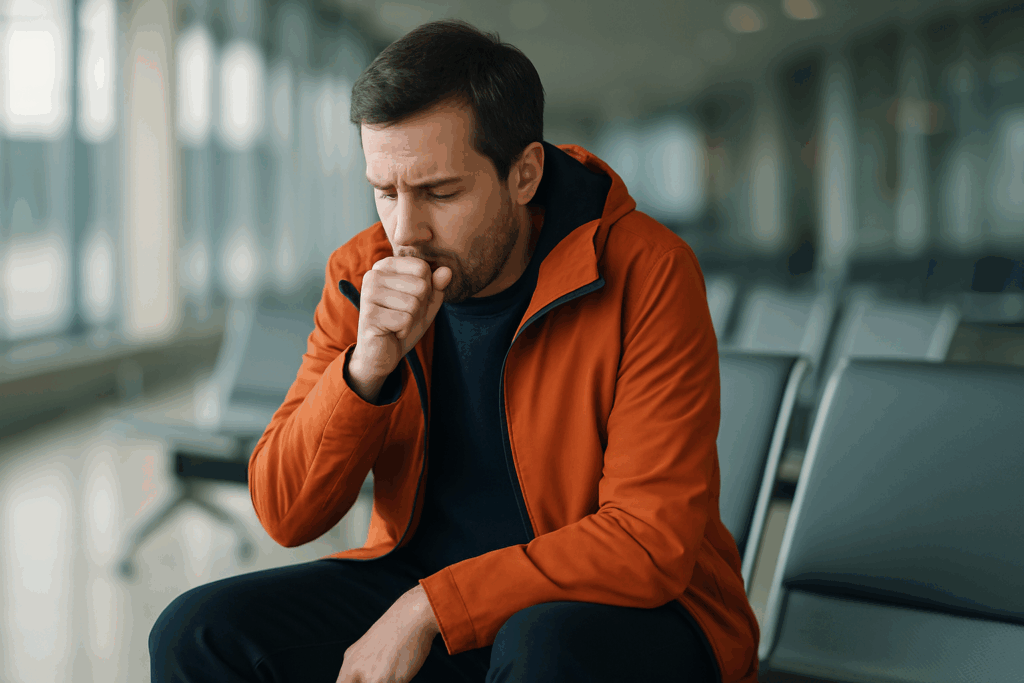 Medical Advice
Medical Advice
Can You Fly with Bronchitis or a Chest Infection?
Planning a flight while recovering from bronchitis or a chest infection can be stressful — especially if you’re unsure what’s safe or allowed. Whether you’re returning home after a holiday, visiting family, or travelling for work, it’s important to understand how flying might affect your breathing, recovery, and risk. In this guide, we’ll explore what you need to know before flying with bronchitis or a chest infection — from airline policies and GP advice to medical escort options and air ambulance alternatives.
Understanding the Risks
- Bronchitis is inflammation of the bronchial tubes, causing coughing, wheezing, and mucus. It can be acute (lasting weeks) or chronic (COPD-related).
- Chest infections, such as pneumonia, affect the lungs and may require medical attention.
Cabin Pressure, Oxygen & Hypoxia
Aircraft cabins are pressurised to around 6,000–8,000 ft. That reduced pressure lowers blood oxygen levels — fine for healthy people, but risky for those with lung infections. This can worsen shortness of breath, chest pain, and the risk of hypoxia. Our guide to flying with a lung condition explains this in more detail, including how oxygen levels are assessed and when extra support is needed.
Contagion & Airline Rules
- Acute bronchitis is contagious — many airlines require a medical clearance or may refuse boarding to prevent spread.
- Airlines often insist passengers are “fit to fly”: no high fever, stable medical status, and non-contagious.
Is Commercial Air Travel Safe?
Yes — under the right conditions:
- For mild bronchitis or chest infections, you may fly commercially once fever is gone and symptoms are mild.
- Bring hydration, inhalers, tissues, and consider a mask to reduce transmission.
- Speak to your GP well in advance — they may recommend supplemental oxygen or specific medication before flying.
- Obtain a fit-to-fly letter or MEDIF form 48–72 hours before departure; airlines ultimately decide.
When an Air Ambulance or Medical Escort is Necessary
Air Ambulance
- For severe infections (e.g., pneumonia or bronchitis with fluid in the lungs)
- Commercial flight cabin pressure is unsafe
- Air ambulance jets can offer sea-level cabin pressure and onboard ICU-level care
Medical Escort
- Stable, non-contagious patients may fly on commercial airlines with a qualified nurse or paramedic escort
- They monitor health, administer oxygen, and ensure timely medication
- This is more affordable than an air ambulance
Tips for Flying with a Chest Infection or Bronchitis
- See your GP early — get clear guidance, prescription meds, and a fit-to-fly letter if needed
- Stay hydrated and bring cough suppressants, tissues, throat lozenges
- Contact your airline early to check medical policies and oxygen support
- Consider medical travel options:
- Medical escort: safe for stable cases
- Air ambulance: best for serious infections — sea-level pressure, oxygen, ICU support
Choose the Right Medical Flight Option
| Situation | Best Option | Why |
|---|---|---|
| Mild bronchitis/chest infection | Commercial flight | Lower cost, quicker — OK when non-contagious |
| Stable but need monitoring | Medical escort | In-flight oxygen, close monitoring, and support with new or ongoing medication |
| Severe infection or fluid build-up | Air ambulance (sea-level) | ICU care, controlled environment, no cabin pressure risk |
Next Steps if You’re Booking a Medical Flight
- Get a medical assessment & documentation from your GP/hospital
- Contact us — the SkyCare team will assess your case and advise: commercial escort or air ambulance
- We’ll handle airline permissions, fit-to-fly arrangements, oxygen logistics, and ensure a medical team is on standby
Bottom Line
Flying with bronchitis or a chest infection can be safe if managed properly. But if in doubt — or if there’s any sign of severity — a medical escort or air ambulance ensures you travel in the safest, most controlled environment for your health.
Reviewed by Dr Lee Collier – SkyCare Repatriation on 21/06/2025 | next review due 21/06/2027 | published on 21/06/2025

 SkyCare
SkyCare 